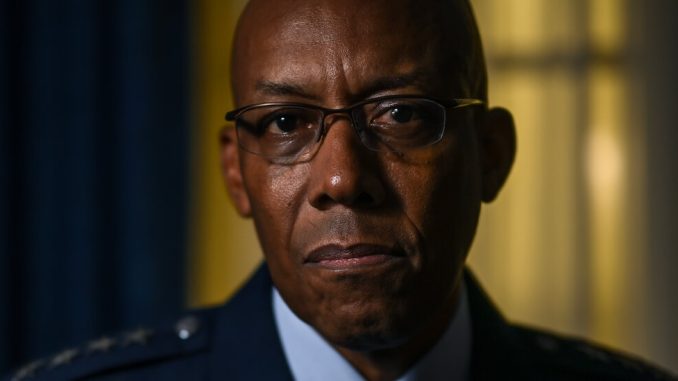
Gen. Charles Q. Brown Jr. is known for being steady in a storm.
There was the time in 1991 when his F-16 was struck by lightning and he had to eject into the alligator-infested Everglades, earning the call sign “Swamp Thang.” The time in 2020, just days before his Senate confirmation vote to be Air Force chief, when he spoke quietly but forcefully in a video of the many African Americans who have suffered the same fate as George Floyd.
And there was this past summer, when his confirmation vote to be President Biden’s senior military adviser was held up for months by a lone Republican senator from Alabama. General Brown, known as C.Q., kept his head down as Democrats and Republicans locked horns.
“You know that old commercial, ‘When E.F. Hutton talks, people listen?’” Gen. David L. Goldfein, a retired former Air Force chief of staff, said in an interview. “C.Q. is the guy in the room who would never have the most words to say, but he always had the most to offer.”
On Friday, General Brown, a four-star Air Force fighter pilot with 130 combat flying hours during his 39 years of service, will be sworn in as the highest-ranking military officer in the country. He will succeed Gen. Mark A. Milley, whose tenure was shaped by a mercurial president and crisis after crisis.
The military is avowedly apolitical, but that proved challenging under President Donald J. Trump, who often tried to use the military for political purposes. The tensions led to the disintegration of his relationship with General Milley. As recently as last week, Mr. Trump was still voicing his ire, calling General Milley a “woke train wreck.”
But General Brown, his colleagues at the Pentagon say, is ready for whatever comes his way in his four-year term.
“In addition to being steady, C.Q. is tremendously collaborative, and a team player, and I believe he’ll be able to work with, and communicate with, and lead, in any situation in the future,” said Admiral Craig S. Faller, who is retired and served with General Brown when they were both at Central Command.
Admiral Faller also was the senior military assistant to Defense Secretary Jim Mattis during the Trump administration. Mr. Mattis resigned two years into his term in protest of Mr. Trump’s Syria policy and his rejection of international alliances.
The admiral said that during their time together at Central Command, General Brown was known for his ability to “lower the pulse beat” on any crisis, whether it was Yemen or Iran or piracy.
“Often C.Q. would be running the counterterror ops, and if I said, ‘C.Q. is going to be there,’ commanders were like, ‘Oh great, no problem then, got it,’” Admiral Faller said.
Born in San Antonio in 1962 to a military family, the young Chuck, as he was called back then, grew up determined to be an architect, even though his father, Charles Q. Brown, served two tours in Vietnam in the Army, retiring as a colonel. His grandfather, Robert E. Brown, served in the Pacific during World War II.
The elder Charles Brown talked his son into joining R.O.T.C. at Texas Tech, telling him that “four years in the military won’t hurt you,” General Brown said in an interview. Six months into it, the young C.Q. wanted out. R.O.T.C. meant less time to hang with his friends and play intramural sports.
But then, during a summer program at Lackland Air Force Base in Texas, he went up in a Cessna T-37, a small, noisy twin-engine that was affectionately known as “Tweety Bird” because of the high-pitched shrieking and whistling it made. The flight was “like a roller coaster,” General Brown recalled.
And just like that, he was hooked.
In 1984, General Brown got his Air Force commission.
Seven years later he was flying an F-16A Fighting Falcon over a populated area near Homestead, Fla., when lightning struck. General Brown saw the flash of light, but it was an Air Force supervisor who told him over the radio that his plane was on fire. General Brown described the story in the usual matter-of-fact way that pilots talk about life-or-death events in the sky.
“He said, ‘You lost your centerline gas tank, and there’s a little bit of fire back there,’” General Brown recalled.
He turned his plane toward the Everglades and pulled the yellow ejection handle, parachuting into the swamp below. And “Swamp Thang” was born.
In the halls of the Pentagon, no one is calling him that now. He is “C.Q.” to all, although enlisted men and women would never say that to his face.
But he electrified those same enlisted ranks with his George Floyd video in 2020. Against a dark background, a solemn General Brown, clad in fatigues, stared into the camera.
“As the commander of Pacific air forces, and a senior leader in our Air Force, and an African American, many of you may be wondering what I’m thinking about the current events surrounding the tragic death of George Floyd,” General Brown said. “Here’s what I’m thinking about.”
Admiral Faller said he was so moved by the video that he called his friend and asked General Brown to appear at one of his weekly virtual “brown bag” sessions.
“Normally, we would get 100 people or so,” Admiral Faller said. “For C.Q., we got, like, 500 people.”


Be the first to comment